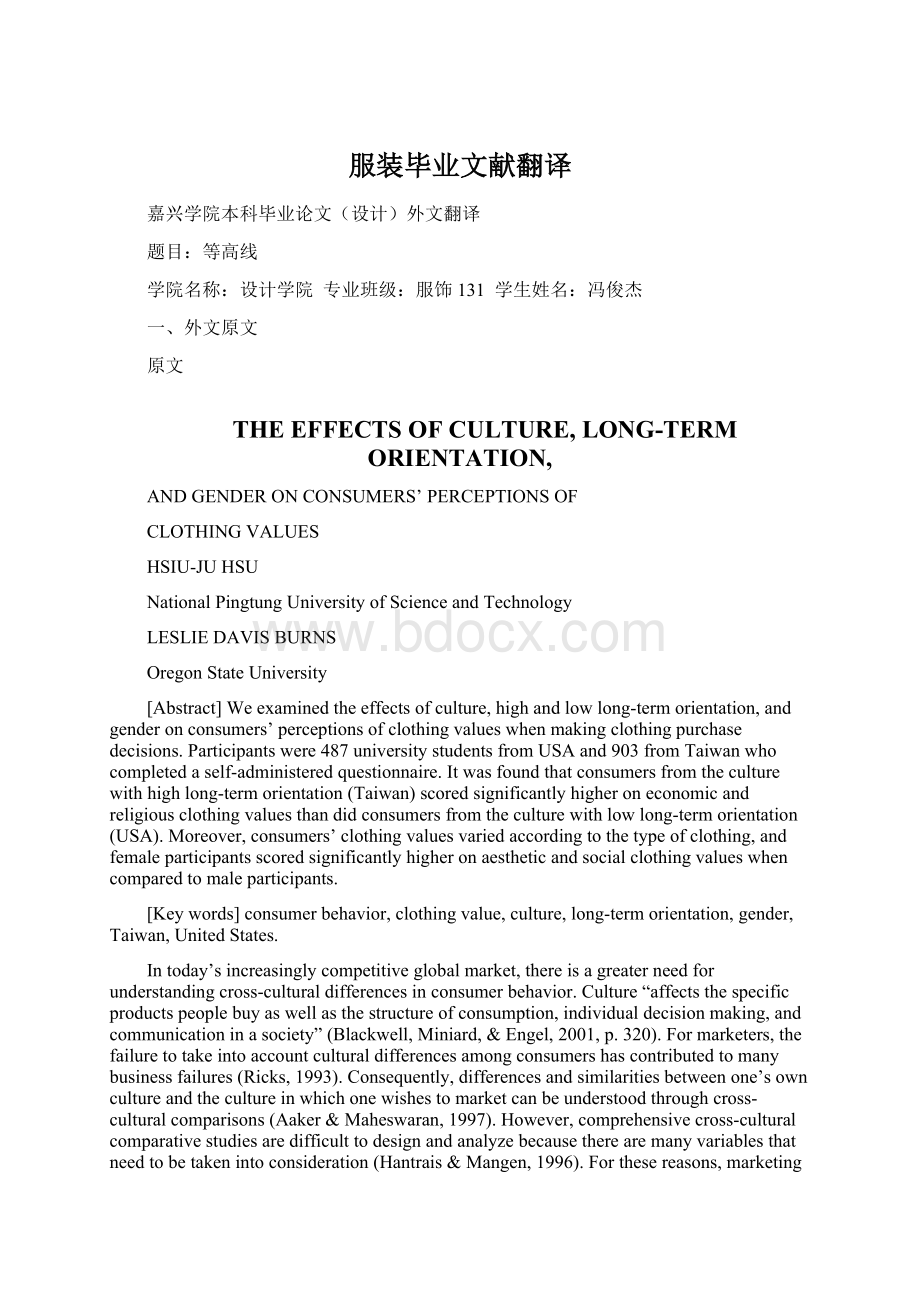服装毕业文献翻译Word下载.docx
《服装毕业文献翻译Word下载.docx》由会员分享,可在线阅读,更多相关《服装毕业文献翻译Word下载.docx(21页珍藏版)》请在冰豆网上搜索。

冯俊杰
一、外文原文
原文
THEEFFECTSOFCULTURE,LONG-TERMORIENTATION,
ANDGENDERONCONSUMERS’PERCEPTIONSOF
CLOTHINGVALUES
HSIU-JUHSU
NationalPingtungUniversityofScienceandTechnology
LESLIEDAVISBURNS
OregonStateUniversity
[Abstract]Weexaminedtheeffectsofculture,highandlowlong-termorientation,andgenderonconsumers’perceptionsofclothingvalueswhenmakingclothingpurchasedecisions.Participantswere487universitystudentsfromUSAand903fromTaiwanwhocompletedaself-administeredquestionnaire.Itwasfoundthatconsumersfromtheculturewithhighlong-termorientation(Taiwan)scoredsignificantlyhigheroneconomicandreligiousclothingvaluesthandidconsumersfromtheculturewithlowlong-termorientation(USA).Moreover,consumers’clothingvaluesvariedaccordingtothetypeofclothing,andfemaleparticipantsscoredsignificantlyhigheronaestheticandsocialclothingvalueswhencomparedtomaleparticipants.
[Keywords]consumerbehavior,clothingvalue,culture,long-termorientation,gender,Taiwan,UnitedStates.
Intoday’sincreasinglycompetitiveglobalmarket,thereisagreaterneedforunderstandingcross-culturaldifferencesinconsumerbehavior.Culture“affectsthespecificproductspeoplebuyaswellasthestructureofconsumption,individualdecisionmaking,andcommunicationinasociety”(Blackwell,Miniard,&
Engel,2001,p.320).Formarketers,thefailuretotakeintoaccountculturaldifferencesamongconsumershascontributedtomanybusinessfailures(Ricks,1993).Consequently,differencesandsimilaritiesbetweenone’sowncultureandthecultureinwhichonewishestomarketcanbeunderstoodthroughcross-culturalcomparisons(Aaker&
Maheswaran,1997).However,comprehensivecross-culturalcomparativestudiesaredifficulttodesignandanalyzebecausetherearemanyvariablesthatneedtobetakenintoconsideration(Hantrais&
Mangen,1996).Forthesereasons,marketingmanagersoftenuseculturalclassifications,suchasnationalculture,todeterminethelimitsofpossibleoverlapbetweenmarketingstrategiesdirectedtowarddifferentculturalmarkets(Steenkamp,Hofstede,&
Wedel,1999).AccordingtotheHofstedenationalcultureframework,nationalcultureiscomposedoffivedimensions:
powerdistance(thedegreeofequalityamongpeoplethatthepopulationofacountryconsidersasnormal:
fromrelativeequalitytoextremeinequality;
Hofstede,1994,p.13),individualism,uncertaintyavoidance,masculinity,andlong-termorientation.Hofstedeassignedcountriesnumericalindicesofeachdimensionaccordingtothedegreetowhichcitizensinthecountryportraythatdimension.InexaminingtheindexvaluesofTaiwanandtheUnitedStates(US)foreachdimension,theUShashighindividualism,andTaiwanhaslowindividualism;
theUShasalowlong-termorientation,andTaiwanhasahighlong-termorientation.Shulrufetal.(2011)haveconductedresearchonnationalculturecomparinghighandlowindividualism;
however,fewstudieshavebeenconductedinwhichthehighandlowlong-termorientationsinHofstede’sframeworkarecompared.
InthisstudywecomparedconsumersinTaiwanandtheUS.Overthepast40yearsTaiwanhasachievedcontinualgrowthinrealpercapitaincomeandingrossnationalproduct.Currently,Taiwanranks16thamongthecountriesoftheworldinsizeofexport,17thinimporting(TaiwanTJCIPInternationalPatentOffice,2010),and4thinholdingforeignexchangereserves(TheRepublicofChinaataGlance,2010).TheUS,HongKong,andJapanarethetopbuyersofTaiwaneseexports,accountingfor45.83%oftotalpurchasesmadein2010(TheRepublicofChinaataGlance,2010).Forcompaniesseekingexpandedinternationalmarkets,anunderstandingofTaiwan’scultureisanimportantelementinformingTaiwanesemarketingstrategies.Indeed,severalresearchershavefounddifferencesbetweentheconsumerbehavioroftheTaiwaneseandthatofAmericans(Hsu&
Burns,2002).TheConfucianphilosophyisoneofthemostdistinctivedifferencesbetweenthetwocultures.ManyscholarsviewtherecentindustrialsuccessofTaiwanasresultinglargelyfromthestrengthofthriftandpersistencevaluesofConfucianism(Chien&
McLean,2011).Confucianismalsoemphasizestheindividual’ssocialrelationshipsandsocialresponsibilityoverself-consciousness:
peopleperceivethemselvesaccordingtotheirsocialrelationshipsandresponsibilitiesasopposedtotheirindividualbeing(Huang,Andrulis,&
Chen,1994).HsiehandScammon(1993)foundthatTaiwaneseconsumerstendtofollowConfucianvaluesofthriftandmoderationinconsumptionandpersonalexpenditure.
AccordingtoHofstede(1994),culturalvaluesrepresent“thedeepestlevelofaculture”and“wearebornwithinafamilywithinanation,andaresubjecttothementalprogrammingofitsculturefrombirth.Hereweacquiremostofourbasicvalues”(p.13).Valuesarelearnedandcanshapeourconsumerbehavior,whichincludesclothingselection.Clothingvaluesaredefinedas“[t]hewishes,desires,interests,motives,orgoalswhichanindividualconsidersworthwhileandthusareinfluentialindetermininghisorherattitudesandbehaviorintheuseofclothing”(Lapitsky,1961,p.3).Researchonclothingvaluesdatesbacktotheearly1930swiththemajorityofresearchersadoptingandadaptingtheworkofAllport,Vernon,andLindzey(1951,1960),resultinginthedevelopmentofsixclothingvalueorientationswithwhichtoexamineclothingselection(Forney,Rabolt,&
Friend,1993):
a.Aesthetic:
Desirefor,appreciationof,orconcernwithbeautyinclothing.
b.Economic:
Desireforconservationoftime,energy,andmoneyinrelationto
clothinguseandselection.
c.Political:
Desireforprestige,distinction,leadership,orinfluencethrough
theuseofclothing.
d.Religious:
Desireforasymbolicallymoralexpressioninclothinguse.
e.Social:
Concernforothersintheuseofclothing.
f.Theoretical:
Desiretounderstandwhyclothingisusedorneededandwhyitsatisfies.
ResearchershavefounddifferencesinclothingvaluesbetweenU.S.consumersandconsumersfrombothcountriesintheMiddleEast(Forney&
Rabolt,1990)andfromNewZealand(Forney,Rabolt,&
Friend,1993).Basedontheculturaldimensionsofhighandlowlong-termorientation,thesixclothingvalueorientationsmayberelatedtoaspectsofHofstede’s(2001)culturalstudyoflong-termorientation.Forexample,consumerwithhighlong-termorientationmaytakeeconomic,political,andreligiousclothingvaluesintoconsiderationwhentheyareshoppingforclothing.ItmightbeConfucianphilosophy(suchasemphasizingtheindividual’ssocialrelationshipsandsocialresponsibilityoverself-consciousnessaswellasmoderationinconsumptionandthriftintheirpersonalexpenditure)thatholdsapositionintheTaiwaneseculture.Ontheotherhand,individualsfromcultureswithlowlong-termorientationmaybeconcernedaboutaesthetic,social,andtheoreticalclothingvalues.Researchoncross-nationalorcross-culturalaspectsofclothingvalueshasbeenconductedtoexamineconsumerbehaviorassociatedwiththeroleofvaluesinclothingselection(Forney,Rabolt,&
Friend,1993).However,inthesestudies“nationality”wasusedasaunit,notnationalculture,tocomparethedifferencesinclothingvalues.AlthoughHaoChiao(1971)conductedacross-culturalstudyinTaiwanandtheUS,themainobjectivewastoexamineclothingbehaviors,notclothingvalues.
Consumersmayconsiderdifferentclothingvalueswhentheyselectdifferenttypesofclothing.Weexaminedthemajorclothingtypeswornbymostpeople:
casualandformal.Forthepurposesofthisstudy,casualclothingisdefinedasclothingonewouldnotweartoanimportantsocialeventortotheoffice(Starr,2012)andformalclothingisdescribedasmen’sorwomen’sclothingsuitableforformalevents(FormalWear,2006).
Inaddition,genderdifferenceshavebeenfoundinrelationtoconsumerbehaviorwithclothing(Cho&
Workman,2011).Allport,Vernon,andLindzey(1951,1960)foundthatmaleshadhighertheoretical,economic,andpoliticalvaluesthandidfemales.Researchersofclothingvalueshavegenerallyfocusedonlyonfemaleconsumers(Creekmore,1963).Basedontheliteraturereview,wewereguidedbythefollowinghypothesesinthepresentstudy:
Hypothesis1a:
Consumersfromaculturewithhighlong-termorientation(e.g.,Taiwan)willscoresignificantlyhigheroneconomic,political,andreligiousclothingvaluesthanwillconsumersinanationalcultureoflowlong-termorientation(e.g.,theUS).
Hypothesis1b:
Consumersfromaculturewithhighlong-termorientation(e.g.,Taiwan)willscoresignificantlyloweronaesthetic,social,andtheoreticalclothingvaluesthanwillconsumersinanationalcultureoflowlong-termorientation(e.g.,theUS).
Hypothesis2:
Consumers’scoresonaesthetic,economic,political,religious,social,andtheoreticalclothingvalueswillbesignificantlydifferentbetweencasualandformalclothing.
Hypothesis3:
Femaleconsumerswillscoresignificantlyhigheronaesthetic,religious,andsocialclothingvaluesthanwillmaleconsumers;
whilefemaleconsumerswillscoresignificantlyloweroneconomic,political,andtheoreticalclothingvaluesthanwillmaleconsumers.
Method
Measure
Aself-administeredquestionnairewasusedtocollectthedataforthisstudy.Thequestionnaireconsistedofthreesections:
thefirstwasusedtomeasureona7-pointscalerespondents’personalviewsonthesixclothingvalues(aesthetic,economic,political,religious,social,andtheoretical)forcasualandformalclothingtypes;
thesecondsectionrelatedtoHofstede